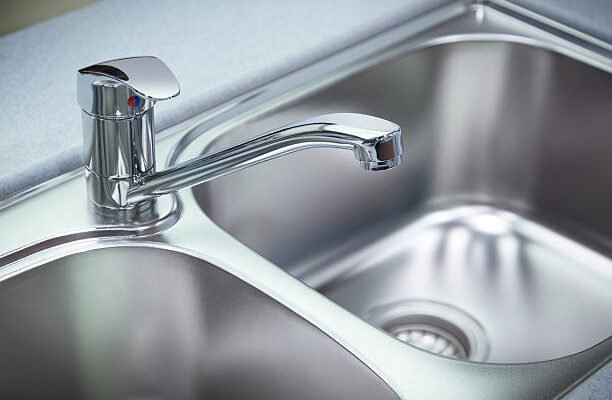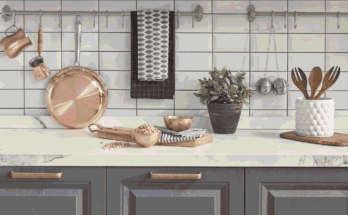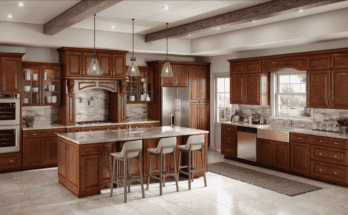1. Introduction
The kitchen sink is one of the most unnoticed parts of any kitchen, but it is also a fundamental part. For cooking, washing, or preparing food, the sink is the most active part of the home and among the most important features. Picking the right kitchen sink is one of the most important decisions, as it depends on the kitchen’s looks and usability. A wrong sink causes many inconveniences, frustrations, and even more complications in maintenance. , the other way is to choose the right sink, which can bring you more convenience and a joyful experience in the kitchen.
Here, you will get acquainted with all the necessary and sufficient information to choose the desired kitchen sink most appropriately. From the variety of sinks, the materials they are made of, and the sizes they are available to how they are installed and what professionals advise, this article will offer you everything you need to know.
2. Types of Kitchen Sinks
Over the years, the choice of kitchen sinks has increased tremendously, and it is rather difficult to choose just one. Each type has its merits, making it easier to choose the right type depending on the kitchen’s style and intended use.
Top-mount Sinks
Drop-in or top-mount sinks are positioned with the top of the sink basin sitting on the countertop, its lip projecting over the countertop. They are particularly preferred for their convenience in Installation and low costs.
The only disadvantage noted is that the rim might tend to accumulate dirt when in use, which makes them normally washed or wiped.
Under-mount Sinks
Under-mount sinks are fitted below the countertop, thus giving an enhanced look. This means that cakes and other similar foodstuffs, when being prepared, do not have issues with counter space getting crumbed because they can simply be swept into the countertop sink. However, they are usually larger in cost as well, and they need a professional to install them.
Farmhouse Sinks
As the name suggests, apron front or farmhouse sinks have a wide, deep well and open front. Their antique look is well-suited for country or classic-style kitchen interiors.
These sinks are suitable for those who do a lot of cooking or deal with large utensils such as pots and pans. Nonetheless, they can be bulky, take up a lot of space in small kitchens, and require special cabinets.
Double-bowl Sinks
There are double-bowl sinks, which are two bowls in one. You wash the dishes in one basin and rinse them in the other. This setup is perfect for people who perform numerous tasks at a given time; however, it minimizes the amount of space needed to store bulky merchandise.
Single-bowl Sinks
Of course, single-bowl sinks are large and ideal for washing large utensils such as pots and baking trays. They also come in handy whenever one is operating in a small kitchen to avoid congestion. However, you do not get the advantage of using the type of sink design that offers opportunities to undertake several activities simultaneously.
3. Sink Materials
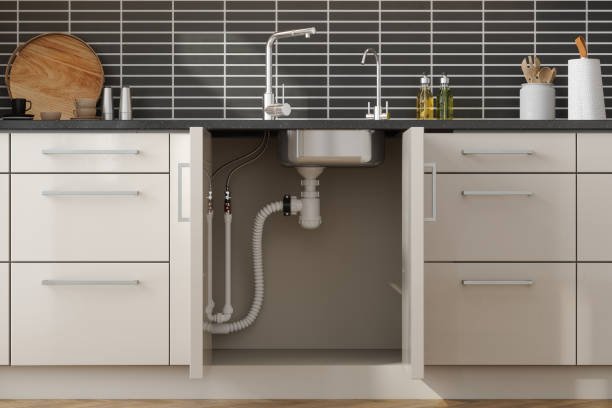
It is important to select the best material for your kitchen sink since it determines its durability, frequency of maintenance and appearance.
Stainless Steel
Stainless steel sinks are long-lasting, heatproof, and compatible with some kitchen designs, including modern designs. It’s also important to note that most of them are relatively cheap and easy to maintain. However, they begin to reveal water spots and scratches after some time.
Granite Composite
Granite composite sinks are a combination of granite stone and resin. They are, therefore, very hardy and withstand abrasions, staining, and heat. They are available in different colors, meaning that one can get one that suits one’s preference. On the other hand, they are heavier and cost more money than the stainless steel versions.
Fireclay
The fireclay material used in fireclay sinks has a non-porous surface, which means that it is shiny, does not develop any stain, and is hardly scratched. They are perfect for individuals who want a modern, country-like kitchen or even a farmhouse-like one. However, since they are larger and heavier and may damage rolled cabinet doors, some form of reinforcement is needed.
Cast Iron
A traditional favorite, cast iron sinks are lined with a porcelain enamel exterior and are thus both tough and attractive. They are hard-wearing, do not absorb stains, and can be used for many years of continuous and constant use. However, the enamel is prone to cracking if subjected to very hard impacts by heavy objects. Furthermore, the cast iron sink is very heavy; thus, it will need the assistance of a professional when installing it.
Copper
Copper sinks are another popular and noble decision due to their antimicrobial finish and warm hue. Copper also acquires a certain hue typical for this metal and assumes a special patina when used for a long time. They, however, are costly and demand a little care when in use so as not to scratch the surface of the accessories.
4. Sink Size and Configuration
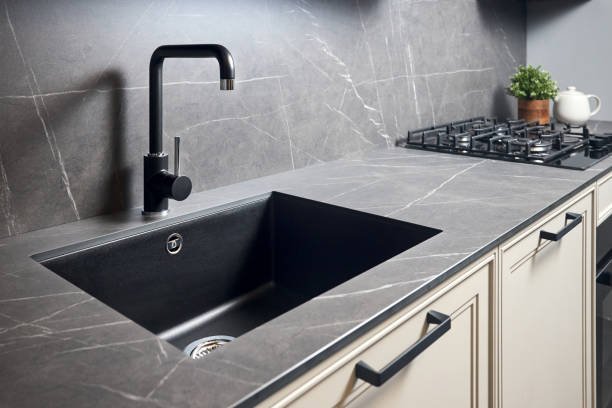
Standard Sizes
Kitchen sinks come in different sizes depending on the size of the kitchen, normally it is between 24 inches to 36 inches. The kitchen’s size and the sink’s usage determine the right size to install. For a big kitchen, a larger sink size of 30-36 inches can be recommended because of space requirements in the kitchen and washing different parts of food products. In small kitchens, a 24-30-inch sink may be more useful because it is a fundamental appliance that cannot be left out when planning the kitchen and its dimensions.
Deep or Shallow?
Deep sinks are useful for washing large-bottomed utensils such as pots, pans, and dishes. They are also useful to reduce splashes to a considerable extent. Yet, using the deep sink to wash dishes or even soothe clothes is tiring, especially on our back. The more shallow ones are convenient to use daily because they do not require bending to reach into them, but they have less storage capacity for big products.
Single vs Double Bowl Configuration
Thus, for example, a single-bowl sink offers a wide space that can accommodate large items to be washed, while a double-bowl sink enhances washing and rinsing as they are done in two different bowls.
Deciding between the two depends on the use you will put your kitchen through. If you spend a lot of time washing and rinsing, or if you prefer to have one part of the sink full of dirty dishes while you wash the other half, then go for a double-bowl sink.
Nonetheless, it is a relatively smaller basin, and if you want the floor space to appear more empty, a single-bowl basin is the way to go.
5. Faucet Compatibility
It is also crucial to select the right faucet for your sink. A sink and faucet should always complement each other in terms of functionality and design.
Single-handle vs Dual-handle
Single-hole, single-handle faucets are very simple to use, as they have only one handle that controls both the temperature and volume of water. They are perfect for the compact sinks and concise designs of modern homes. However, another type of faucet, dual-handle faucets, helps control both the hot and cold water independently and is preferred for most conventional kitchens.
Pull-out Sprayer vs Fixed Faucet
It’s a pull-out sprayer that is very handy when washing dishes, washing small spaces such as the corners, and filling pots from outside the sink. Finer spread faucets are more conventional and are known to be rigid as compared to other types of faucets. When selecting a faucet, you should consider adding a pull-out or pull-down sprayer option, which can significantly improve the utility of a sink.
6. Installation Options

Drop-in vs Undermount Installation
Drop-in sinks can be installed by placing the sink in a hole that has been cut on the countertop, making them easier for a do-it-yourself job. They are also normally less costly to incorporate into building structures than conventional types of roofs.
Undermount sinks, on the other hand, require some technicality when installed because they are installed beneath the countertop. This installation should be done by an expert to avoid any problems that might arise.
Professional Installation vs DIY
Some sinks, such as top-mount models, can be installed by homeowners, but more complicated sinks, such as extra-heavy or under-mount sinks, should be installed by a professional. Therefore, when choosing your sink, make sure to consider the price and the effort and space required in installation.
7. Durability and Maintenance
Scratch and Stain Resistance
Some of these include stainless steel and granite composite. These materials are well known for their ability to resist scratching and staining and are, therefore, good for high-traffic kitchens. Fireclay and cast iron are also resistant materials, but more attention should be taken when using them to prevent them from getting damaged over time.
Ease of Cleaning
Sinks’ cleaning abilities vary. Stainless steel and fire clay are self-polishing and only need to be wiped occasionally; copper needs to be refinished to prevent it from developing a patina. Granite composite sinks do not facilitate stains or water spots and are ideal for very busy families.
8. Choosing the Right Style
Modern vs Traditional
Your sink should blend with the rest of the décor of your kitchen. Contemporary kitchens are best matched with glossy undermount stainless steel or granite composite sinks. In contrast, traditional or farmhouse-style kitchens are best complemented with fire clay or cast iron Farmhouse sinks.
How Your Sink Fits into Your Kitchen’s Design
Also, consider how the sink will complement your counters, cabinets, appliances, and the utensils you will be washing on it. A deep farmhouse-style sink could be the star of a country style, whereas a chic under-mount sink would be more appropriate for a glass, steel, and high-tech look.
9. Water Efficiency
Faucets with Water-saving Features
Because there are now low-flow faucets, you do not have to sacrifice performance to conserve water. The models you should look for should have aerators or flow regulators to ensure that water is saved when pressure is regulated.
Aerators and Flow Regulators
These minute features can thus assist you in conserving water and, therefore, effectively reduce your spending. Aerators enable air mixing with water and hence use less water than the flow regulators that enable the control of water flow so that it does not use a lot of water.
10. Budget Considerations
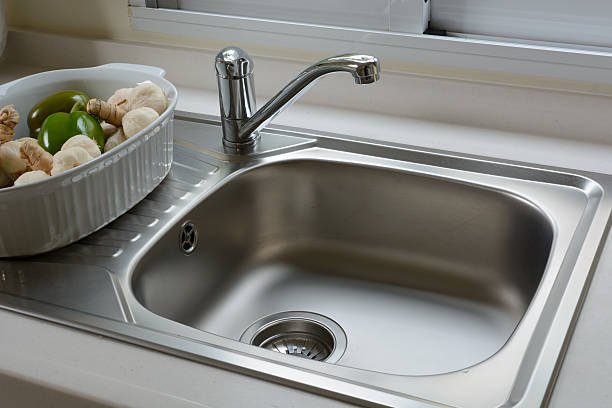
Budget-friendly Sinks
Many times, basic stainless steel kitchen sinks are the least expensive, but they do not compromise on quality. The relatively simple installation method makes Top-mount sinks comparatively cheaper than the under-mount ones.
Luxury Sinks and What They Offer
If you want to make a statement, investing in luxury materials like copper or custom-made granite composite can elevate your kitchen’s design. These high-end sinks often offer superior durability and a unique aesthetic, but they come with a higher price tag.
11. Expert Insights
Professional interior designers stress the importance of considering form and function when choosing a kitchen sink. “Your sink is a workhorse in the kitchen, but it also contributes to the overall aesthetic,” says designer Anna Davis. “Don’t compromise on quality, but also ensure it fits with the look and feel of your kitchen.”
12. Case Study
In one kitchen renovation project, a family opted for a granite composite sink to complement their modern kitchen. The deep single-bowl design provided ample space for large pots, while the durable granite material resisted scratches and stains from heavy use. This sink choice enhanced their kitchen’s functionality and elevated its sleek, contemporary design.
13. Future Trends
Emerging Materials and Designs
As kitchen technology advances, expect to see more innovative materials and designs. Materials like quartz composite and eco-friendly recycled sinks are becoming more popular. Additionally, touchless faucets and smart water-saving technology are increasingly being integrated into modern kitchen designs.
14. Conclusion
Choosing the perfect kitchen sink for your needs involves balancing style, functionality, and durability. Whether you prefer the sleek look of an under-mount stainless steel sink or a farmhouse sink’s rustic charm, endless options are available to suit your kitchen. By considering material, size, configuration, and installation, you can ensure that your new sink meets your aesthetic and practical needs.
FAQs
[saswp_tiny_multiple_faq headline-0=”h2″ question-0=”Which type of kitchen sink is the easiest to clean?” answer-0=”Top-mount sinks can collect grime around the rim, making them a bit harder to clean. On the other hand, under-mount sinks offer a sleek design that allows you to sweep crumbs directly into the sink. Stainless steel and granite composite sinks are generally easy to clean due to their durable and smooth surfaces.” image-0=”” headline-1=”h3″ question-1=”What is the most durable material for a kitchen sink?” answer-1=”Granite composite and stainless steel sinks are considered the most durable. Granite composite sinks resist scratches, stains, and heat, while stainless steel sinks are heat-resistant and easy to maintain. However, granite composite is heavier and more expensive compared to stainless steel.” image-1=”” headline-2=”h3″ question-2=”Should I choose a single-bowl or double-bowl sink?” answer-2=”If you frequently multitask in the kitchen, like washing dishes and rinsing simultaneously, a double-bowl sink may suit your needs. However, if you need more space for large pots and pans, a single-bowl sink might be a better option.” image-2=”” headline-3=”h3″ question-3=”Can I install a kitchen sink myself, or do I need professional help?” answer-3=”Top-mount sinks are easier to install and can be a DIY project for many homeowners. However, under-mount, farmhouse, or heavier materials like granite or fireclay may require professional installation due to their complexity and weight. ” image-3=”” headline-4=”h3″ question-4=”What size kitchen sink should I choose?” answer-4=”For larger kitchens, a 30-36 inch sink provides ample space for washing and food prep. In smaller kitchens, a 24-30 inch sink is usually more practical. The depth of the sink also matters; deeper sinks are great for large items, but they can strain your back.” image-4=”” count=”5″ html=”true”]

